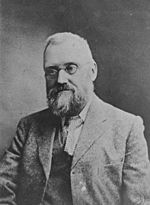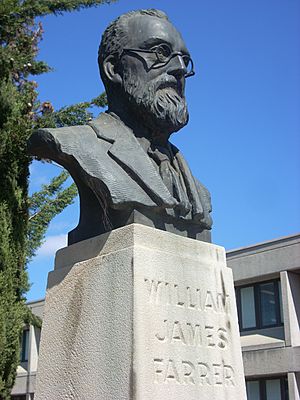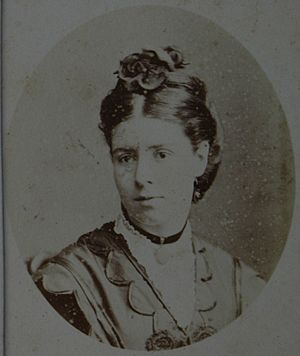William Farrer facts for kids
Quick facts for kids
William Farrer
|
|
|---|---|

William Farrer
|
|
| Born | 3 April 1845 Docker, Westmorland, England
|
| Died | 16 April 1906 (aged 61) Tharwa, New South Wales, Australia
|
| Alma mater | Cambridge University |
| Known for | Wheat breeding |
| Scientific career | |
| Fields | agronomy |
William Farrer (born April 3, 1845 – died April 16, 1906) was an important English Australian scientist. He was an agronomist, which means he studied soil and crops, and a plant breeder, meaning he developed new types of plants. Farrer is best known for creating a special kind of wheat called "Federation" wheat, which was shared with farmers in 1903. His work greatly improved the quality and amount of wheat grown in Australia. Because of his contributions, he is often called the 'father of the Australian wheat industry'.
Contents
Who Was William Farrer?
Early Life and Education
William Farrer was born on April 3, 1845, in a town called Docker, in England. His father, Thomas Farrer, was a farmer. William was a very smart student and won a scholarship to Christ's Hospital in London. He was excellent at mathematics and later earned another scholarship to Pembroke College at Cambridge University. He finished his studies there in 1868.
Moving to Australia and Early Career
In 1870, Farrer moved to Australia. He had tuberculosis, a lung disease, and hoped that Australia's drier and warmer weather would help him feel better.
He first lived with friends in Parramatta, then worked as a tutor in Duntroon, which was a rural area in New South Wales. In 1873, he wrote a paper about how different soils were good for grasses and the science of sheep farming. After tutoring, he became a surveyor in 1875. He worked for the Department of Lands in New South Wales, surveying land in wheat-growing areas from 1875 to 1886.
Family Life and Starting a Farm
In 1882, Farrer married Henrietta Nina. Her father, Leopold Fane de Salis, was a Member of Parliament. Four years later, Nina's father gave her 97 hectares of land. This land, called "Lambrigg," was near Tharwa in what is now the Australian Capital Territory. Farrer tried to grow grapes there, but the soil wasn't right. So, he decided to focus on growing wheat instead. His main goal was to produce wheat that could make a really good loaf of bread. He thought of himself as a scientific gardener.
Farrer's Wheat Experiments at Lambrigg

Fighting Wheat Diseases
One big problem for farmers was a disease called Wheat leaf rust, which damaged wheat crops and reduced how much wheat they could harvest. Farrer used his scientific knowledge to create new types of wheat that could fight off this disease. He used a method called cross-pollination, which involves mixing pollen from different plants to create new varieties. He even used hairpins to transfer pollen before he got proper tools!
His scientific experiments went on for over 20 years. He spent long days planting and developing new wheat types. He used methods similar to those of Gregor Mendel, a famous scientist who studied how traits are passed down in plants. Farrer also used special procedures developed by Frederick Bickell Guthrie to test how much flour and bread could be made from his new wheat types. He carefully wrote down all his results in notebooks.
Farrer also communicated with other plant breeders around the world. He talked with Henri Vilmorin, a French wheat breeder who focused on growing wheat in dry areas. He also learned from plant breeders in India.
At the same time, Farrer worked on developing wheat that could resist another damaging disease called bunt or smut-ball.
Developing New Wheat Strains
Farrer carefully chose and bred different wheat varieties, like "Professor Blount's Hybrid No.38, Gypsum," Canadian Fife, Etawah, and Purple Straw. His goal was to combine the best qualities of each into one new type of wheat.
He finally succeeded in 1900, when he developed a strong, rust-resistant, and high-yielding wheat called the "Federation" strain. He named it after the upcoming Federation of Australia, when the different Australian colonies would unite. He then created other successful strains like Canberra, Firbank, Cleveland, Pearlie White (named after a child who was interested in his work), and Florence (which could resist flag smut). Because of his successes, Farrer became a wheat experimentalist for the New South Wales Department of Agriculture in 1898.
These new wheat types greatly improved Australia's wheat industry very quickly. The Federation strain was given to Australian farmers in 1903. Within twenty years, Australia's wheat harvest tripled! Wheat export then became a major business for Australia around the world.
William Farrer's Lasting Impact
Death and Memorials
Farrer passed away at his home, Lambrigg, in 1906 after having a heart attack. He was buried on his property the next day.
In 1911, the Farrer Memorial Trust was created to honor him. This trust first offered scholarships for students studying agriculture. In 1936, the trust started giving a medal for excellent work in agricultural science. The first person to receive this medal was Joseph Lyons, who was the Prime Minister of Australia at the time. Statues of Farrer were put up in Queanbeyan in 1935 and at Lambrigg in 1938 to remember him.
Honoring His Legacy
Many places and things have been named after William Farrer to honor his important work:
- A suburb and a primary school in Canberra are named after him. The school's logo is a wheat sheaf, and its sports teams are named after his famous wheat types.
- An Australian voting area, the electoral division of Farrer, is named after him.
- Farrer was also shown on the back of the Australian two-dollar banknote, which was used from 1966 until it was replaced by coins.
- A special agricultural high school, Farrer Memorial Agricultural High School in Tamworth, New South Wales, is named in his honor and still teaches students about agriculture.
- There is also a student residence hall at Monash University named after him.
- In Wagga Wagga, New South Wales, there is a Farrer Hotel and a Farrer Football League for Australian rules football.


